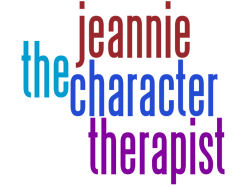|
Bipolar
disorder seems to be a popular disorder for writers.
Not that the writers suffer from
this disorder themselves, but often their characters do. Why? The
motivation is simple: Someone who alternates between depressed spells
and super-duper energetic mania makes for a more interesting,
multilayered character than someone who stays in bed all day, crying
and eating.
I have a problem when authors
seemingly pluck bipolar disorder from the Box o’ Character Vices and
unrealistically portray it on their pages. My theory is that bipolar
disorder gets picked on and abused because of its unusual and
fascinating nature.
When someone mentions bipolar,
most people immediately think of a person jumping back and forth
between depression and mania like they are on a pogo stick. While this
depiction is clinically simplistic, it exemplifies how mental disorders
become clichéd or stereotyped. For example, not all who have
schizophrenia hear voices, not all people with obsessive-compulsive
disorder wash their hands until they are raw, and not all people with
eating disorders throw up.
Discussing mania is the best
place to put an end to the misuse of this disorder. A person can
experience varying degrees of mania. Some people go into full-blown mania,
which impairs their functioning ability and lasts for at least a week,
but others experience only hypomania, which is an
elevated mood lasting four to seven days. When the person is actively
manic, they don’t think or admit that anything is wrong. They probably
look forward to those time periods, where they have endless energy,
need little sleep, and are prolifically creative and productive.
Sadly, they also usually max out
credit cards, dwindle away their savings by gambling, or get into car
accidents for recklessly driving too fast. Depending on what their vice
is when they aren’t actively in the throes of mania, a person with
bipolar disorder will overindulge and “binge” on that vice. For
instance, an author who is bipolar will most likely binge on writing
when they are manic.
The depression experienced by
sufferers of bipolar disorder also varies. Some get so depressed they
experience psychotic symptoms like hallucinations or paranoia. Some
have a milder form of depression, like being so melancholic they can’t
fathom getting out of bed. Both forms of depression interfere with
day-to-day functioning. Depression is far more likely to dominate the
person’s life than mania or hypomania, which is not the prevailing
association with bipolar. (Remember the pogo stick?)
I want to address the issue of
swinging back and forth. When a person makes this “swing,” it’s called cycling.
Usually the two extremes bookend periods of normalcy, a fact that often
gets left out of fictional depictions. Characters with this disorder
don’t always have to act erratic or unpredictable, they can just be
“themselves.”
Only 10 to 20 percent of people
with bipolar have what is called rapid cycling.
Rapid cycling means that the person experiences at least four episodes
of depression or mania a year. That’s a year,
|
not
every couple of pages
in your manuscript. It’s far more likely that the person lingers
through each stage a bit longer, but no two people cycle the same.
Janice might cycle every three
months regularly, while Peter might switch from mania to depression in
January, be fine for ten months, and then switch again from mania to
depression in December. Because both of them have four episodes within
a year, they both are considered rapid cyclers, but you can see how
Janice’s life would be very different from Peter’s (and therefore make
for a far different character).
Okay,
then. On to my recommendations for how to write a character with
realistic bipolar disorder:
Be purposeful.
Don’t let a lack of plot drive you to pigeonholing a character with
bipolar. If your character needs something to “shake things up” midway
through a sagging middle, don’t use bipolar to do it. Giving a
character bipolar as a way of explaining their erratic or
out-of-the-norm behavior takes the easy way out.
Pass time by utilizing
the cycles. It’s just not probable for a character to be
terribly depressed on one page, bouncing around like a Ping-Pong ball
the next page, and then crying again by the very next page. I’ve read
this scenario, and it just made me roll my eyes. While it may be fun to
write, it’s not common, so therefore it’s not realistic.
Become familiar with
what can trigger a switch into the opposite extreme. A few
triggers can
realistically cause someone to cycle into mania or depression. Some of
the more common ones are use of alcohol and drugs—antidepressants, as
well as street drugs—and life stressors, like death of a loved one and
loss of job.
Don’t overdo
it. A little bipolar goes a long way.
A Web site to tuck away
for future research is the Depression and Bipolar Disorder Alliance
site, www.dbsalliance.org.
They have great downloadable .pdf files to
reference under their Learn About Mood Disorders tab. If you want to
understand in layman’s terms more about how rapid cycling can vary,
visit http://bipolar.about.com/od/rapidcycling/a/laymensrapid.htm.


|